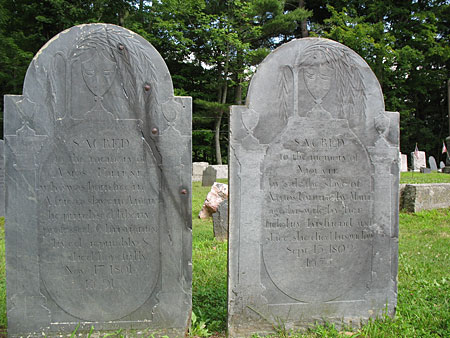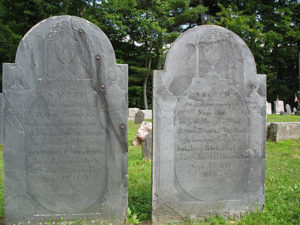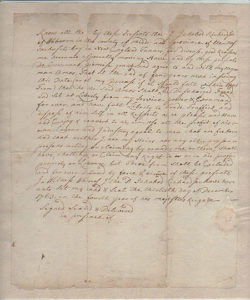Amos Fortune, Free Man: New Uses for a Children’s Classic

New Uses for a Children’s Classic
U.S. history is taught frequently in students’ early schooling, often twice in grades K-8, and once more in the guise of state history. Given the chronological nature of the subject, teachers usually “begin at the beginning” and invariably run out of time before reaching the twenty-first century. The frequency with which early American events are taught has had an unexpected consequence: it has helped ensure the longevity of children’s books set during the seventeenth and eighteenth centuries.
The ubiquity of titles like Johnny Tremain (set during the American Revolution) and The Witch of Blackbird Pond (set in seventeenth-century Connecticut) is a boon for middle and high school teachers searching for effective ways to introduce students to historiographical debates and the challenge of constructing coherent historical narratives from spotty historical records. When historical novels are juxtaposed with the primary sources that inspired them, they invite readers to think deeply about what it means to “do history,” to conduct the research that lies at the heart of the historical endeavor.
When historical novels are presented as works of historical interpretation, they can also serve as tools that help students learn to “read like historians.” The new Common Core State Standards call for the deliberate teaching of literacy across school subjects, a demand that derives from acknowledgement that each discipline brings distinct skills to bear on the reading and analysis of text. The literature surrounding the Common Core and, in fact, the Common Core standards themselves, however, operate on the assumption that history students primarily require instruction on how to derive meaning from textbooks and historical documents. Given that historians read all texts, including literature, in distinctive ways, this is shortsighted.
Elizabeth Yates’ Amos Fortune, Free Man is one novel that provides a means for students to both “do” early American history and practice reading like a historian. Published in 1950, Amos Fortune, Free Man is a fictional biography of a real man now buried in an integrated cemetery in Jaffrey, New Hampshire. The book won the 1951 Newbery Medal, a coveted award granted annually by the American Library Association to the author of “the most distinguished contribution to American literature for children.” Children’s books recognized with the Newbery enjoy significantly longer shelf-lives than the industry standard, and Amos Fortune is no exception. While not as widely taught as Newbery winners Johnny Tremain and The Witch of Blackbird Pond, or Newbery Honor Book My Brother Sam is Dead (like Johnny Tremain, a Revolutionary War novel), Amos Fortune does regularly figure in grade-school curriculum. Twelve percent of U.S. states host recommended reading lists on their Department of Education Websites, and of these, half, including the states of California and New York, list Amos Fortune among titles for middle school students. Yates’ novel is also warmly embraced by the Christian homeschool community.
Little is known about the historical Fortune, but surviving documents make clear the remarkable nature of his story. Taken captive in Africa, he died in New England a respected freedman of some means. Fortune was owned by and apprenticed to a tanner in his young manhood, and he practiced this trade in New Hampshire once freed. His business flourished, enabling him, upon his death, to leave a “handsome present” to the church, as well as a monetary gift to the local school. Dividends from the school funds were used for student prizes as late as the 1930s (and later for other educational purposes), but it wasn’t until Elizabeth Yates’ novel appeared at the onset of the Civil Rights movement that Fortune’s name became more widely known.
Yates’ novel celebrates its extraordinary protagonist, but it is a white apologist narrative for slavery. The story begins in an African village where fifteen-year-old At-Mun is captured, marched to the sea, and placed on a Boston-bound slaver. No records of the historical Fortune exist prior to his membership in a Massachusetts household. Yates therefore borrows a literary trope common in the eighteenth and nineteenth centuries to establish his pre-American identity as a tribal prince. This fictional heritage becomes an explanatory device for Yates: Amos’ royal blood gives him the ability to withstand the Middle Passage with self-respect intact. The custom of imagining American slaves as African royalty has a history of its own, however: the practice flattered slave owners by rendering them masters of another nation’s kings. What might it mean, then, for an elite white woman writing in the 1940s to imagine Amos Fortune as an African prince, and to craft his life story as a narrative in which he is grateful for having been brought to New England?
Extant documents reveal Amos Fortune’s status as a slave in the 1760s and then, beginning in 1770, as a freedman, landowner, tanner (with apprentices), husband, church member, and benefactor. In themselves, the legal documents are static, archaic documents that require a narrator to become story. Yates steps into the role, drawing on local histories of Jaffrey, New Hampshire, and widely circulated scholarship on slavery to make sense of Fortune’s life. In the novel, Amos’ first master informs his wife that, Quaker principles notwithstanding, Amos could not be freed immediately as he “is part animal now. What would he do but run wild?” (35).
Given Yates’ sources, as well as her social position, it should come as no surprise that she embeds Fortune’s life within an understanding of slavery as a “school for civilization.” The belief that bondage was a necessary way station between African “savagery” and American citizenship was widely embraced by mainstream historians, and the public at large, in the pre-Civil Rights era in which Yates wrote. Amos Fortune is in line with contemporaneous historiography. If the premise that slavery was a “school for civilization” was replaced with one that declared slavery fundamentally oppressive, we might ask, how would the fictionalized version of Amos Fortune—and his masters—differ? How would Amos Fortune read differently?
The slave trade is condemned in Yates’ novel, but slavery is redeemed, in large part because it brings African “pagans” to Christ. In structuring Amos Fortune as a Christian conversion narrative, however, Yates implicates Amos—and by extension, Africans at large—in his bondage. Amos refuses freedom papers when they are offered because “he did not want his life to be apart from [Master] Caleb’s in any way” (46). Amos was content in the Copeland household and he believed political freedom meaningless without the promise of salvation; thus, he wished to secure heaven first. Predictably, his earthly master dies insolvent and Amos is sold to pay the debts.
Yates’ political and religious beliefs—she was raised in a wealthy Catholic home steeped in noblesse oblige and the dictum that “to work when there was no need was to deprive someone for whom there was need”—likely influenced her decision to solve an interpretative problem posed by the records in this way. A 1763 manumission paper declaring Amos free in four years’ time—or upon the death of his master Ichabod Richardson—was drawn but not signed, rendering it nonbinding. When Richardson died five years later, Amos was still enslaved, and Richardson’s will neglected to mention him. This made Amos the property of his heirs. Why did an unsigned manumission paper exist? Yates’ explanation—that Amos turns down freedom—bridges the evidentiary gap and makes for a compelling story. But it also advances a historical argument whose implications most find deeply troubling today. In effect, it transfers responsibility for Fortune’s continued enslavement from his white owners and a flawed system of legal protection to a single disenfranchised slave.
Like the vast majority of children’s novels taught in schools, Amos Fortune, Free Man was widely praised at the time of its publication. Now a half-century later, historical interpretations of slavery and social sensibilities about race have changed dramatically. Yet as its updated paperback cover reveals, the novel continues to circulate briskly, appearing on the recommended reading lists for Alaska, California, and New York. Teaching Amos Fortune, Free Man as “timeless” literature is troublesome, but tapping the novel’s potential to teach students the importance of contextualization and to coach them in reading for historical argument and subtext is pedagogically exciting.
The historical Amos Fortune willed monies to his local schoolhouse upon his demise. Amazingly, those funds continue to benefit students today. A portion of proceeds from the initial bequest paid for publication of Peter Lambert’s educational booklet, Amos Fortune: The Man and His Legacy (2000). This classroom guide provides background information on Fortune’s life and transcribes all relevant historical documents found to date. With this resource and Yates’ novel in hand, students born nearly three centuries after Fortune can hone their skills in historical research, analysis, and thinking as they piece together both the history and memory of his life.
Further Reading:
For historical background on Amos Fortune, see Peter Lambert, Amos Fortune: The Man and His Legacy (Jaffrey, N.H., 2000) and Albert Annett and Alice E.E. Lehtinen, History of Jaffrey (Jaffrey, N.H., 1937). Elizabeth Yates described her research and writing process in “Acceptance Paper: Climbing Some Mountain in the Mind,” in Bertha Mahony Miller and Elinor Whitney Field, eds., Newbery Medal Books, 1922-1955, with the authors’ acceptance papers and related material, chiefly from the Horn Book Magazine (Boston, 1955). For the quotation about noblesse oblige, see Elizabeth Yates, My Diary—My World (Philadelphia, 1981). On Yates’ social background, see discussion of her father, Harry Yates, the Buffalo, New York coal magnate, in Joseph F. Bieron and Suzanne S. Kulp, Orchard Park: Images of America (Portsmouth, N.H., 2003). On the use of Christian conversion as a structuring device for slave narratives, and on the practice of imagining African captives as royalty, see Angelo Constanzo, Surprising Narrative: Olaudah Equiano and the Beginnings of Black Autobiography (New York, 1987) and Frances Smith Foster, Witnessing Slavery: The Development of Ante-bellum Slave Narratives, 2nd ed. (Madison, 1979). Ulrich Bonnell Phillips, American Negro Slavery: A Survey of the Supply, Employment, and Control of Negro Labor, as Determined by the Plantation Regime (1918) was the prevailing interpretation of American slavery at the time Yates penned Amos Fortune. On Amos Fortune’s reception history, see Donnarae MacCann, “Racism in Prize-Winning Biographical Works,” in Donnarae MacCann and Gloria Woodard, eds., The Black American in Books for Children: Readings on Racism, 2nd ed. (Metuchen, N.J., 1985).
Sharon M. Draper, Copper Sun (New York, 2006) is a recent historical novel that, while set in the South and not based on a specific historical figure, parallels Amos Fortune by including capture in Africa, the Middle Passage, and ultimate achievement of freedom. Other historical novels to consider include, on captivity, Indian removal, and colonial warfare, Conrad Richter, Light in the Forest (1953), Elizabeth George Speare, Calico Captive (1957), Elizabeth George Speare, The Sign of Beaver (1983), and Joseph Bruchac, The Winter People (2002); on witch trials, Elizabeth George Speare, The Witch of Blackbird Pond (1958), Ann Lane Petry, Tituba of Salem Village (1964), and Ann Rinaldi, A Break With Charity: A Story About the Salem Witch Trials (2003); and on the American Revolution, Esther Forbes, Johnny Tremain (1943), James Lincoln Collier and Christopher Collier, My Brother Sam is Dead (1974), Scott O’Dell, Sarah Bishop (1980), Laurie Halse Anderson, Chains: Seeds of America (2008), and M.T. Anderson, The Astonishing Life of Octavian Nothing, Traitor to the Nation, Vol. I: The Pox Party (2006).
For a broader discussion of children’s historical novels and their role in school curriculum, see Sara L. Schwebel, Child Sized History: Fictions of the Past in U.S. Classrooms (Nashville, 2011), “Rewriting the Captivity Narrative for Contemporary Children: Speare, Bruchac, and the French & Indian War,” New England Quarterly 84, 2 (2011): 318-46, and “Historical Fiction and the Classroom: History and Myth in Elizabeth George Speare’s The Witch of Blackbird Pond,” Children’s Literature in Education 34 (2003): 195-218.
This article originally appeared in issue 12.4 (July, 2012).
Sara L. Schwebel is assistant professor of English at the University of South Carolina and author of Child-Sized History: Fictions of the Past in U.S. Classrooms (2011).

